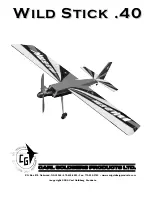
3
Don’t operate your model in the vicinity of overhead power cables, industrial sites, residential
areas, public roads, squares, school playgrounds, public parks or sports fields etc.
Don’t ignore our warnings. They refer to hazardous materials and processes which, if ignored,
can result in fatal injury or serious damage to property.
Propellers and other rotating parts which are powered by a motor represent a permanent
hazard and present a real risk of injury. Don’t touch them with any part of your body. For
example, a propeller spinning at high speed can easily slice off your finger.
Keep well clear of the rotational plane of the propeller. You never know when some part (or the
whole propeller) may come loose and fly off at high speed, hitting you or anybody else in the
vicinity; this can result in serious injuries. Never touch the revolving propeller with any object.
Ensure that there is no chance of any object obstructing the propeller and preventing it
turning.
Take care with loose clothing such as scarves, loose shirts etc. Flapping cloth can easily be
sucked into the area of the propeller and then get tangled in the blades. This is extremely
dangerous.
Every time you intend flying the model, check carefully that all parts connected to it are
working correctly, including propeller, gearbox, RC components, etc. Everything must be
properly located and firmly secured. Check for possible damage, and do not fly your model
unless you are confident that everything is in perfect order.
Whenever you are working on the motor, make sure that you are on a safe surface and cannot
slip. Wear high-grip shoes such as trainers.
Satisfy yourself that your frequency is vacant before you switch on. Radio interference caused
by unknown sources can occur at any time without warning. If this should happen, your model
will be uncontrollable and completely unpredictable. Never leave your radio control system
unguarded, as other people might pick it up and try to use it.
Do not switch on an electric motor unless you are sure that there is nothing in the rotational
plane of the propeller. Don’t attempt to stop the spinning propeller with your hands. Never run
an electric motor with a propeller fitted unless it is firmly anchored.
If you are to fly your model safely and avoid problems it is essential that you are aware of its
position and attitude throughout each flight - so don’t let it fly too far away! If you detect a
control problem or interference during a flight, immediately land the model to prevent a
potential accident. Models must always give way to full-size aircraft. Take-off and landing
strips should be kept free of people and other obstacles.
Your RC system can only work reliably if the batteries are kept fully charged.
Never use batteries which are hot, faulty or damaged. Always heed the instructions provided
by the battery manufacturer.
Before every flight be sure to carry out a range check, and ensure that all functions are
working correctly. Note in particular that the motor control function on the transmitter must
first be set to the OFF position before you switch on the system. Always switch on the
transmitter first, then the receiving system, to eliminate any chance that the motor will burst
into life unexpectedly. When switching off, reverse the order: receiving system first, then the
transmitter.
Check that the control surfaces move in the direction which corresponds to the stick
movement:
If you move the rudder stick to the right, the right-hand elevator should move down and the
left-hand elevator up.
Pull the elevator stick back towards you, and both elevators should rise.
















































